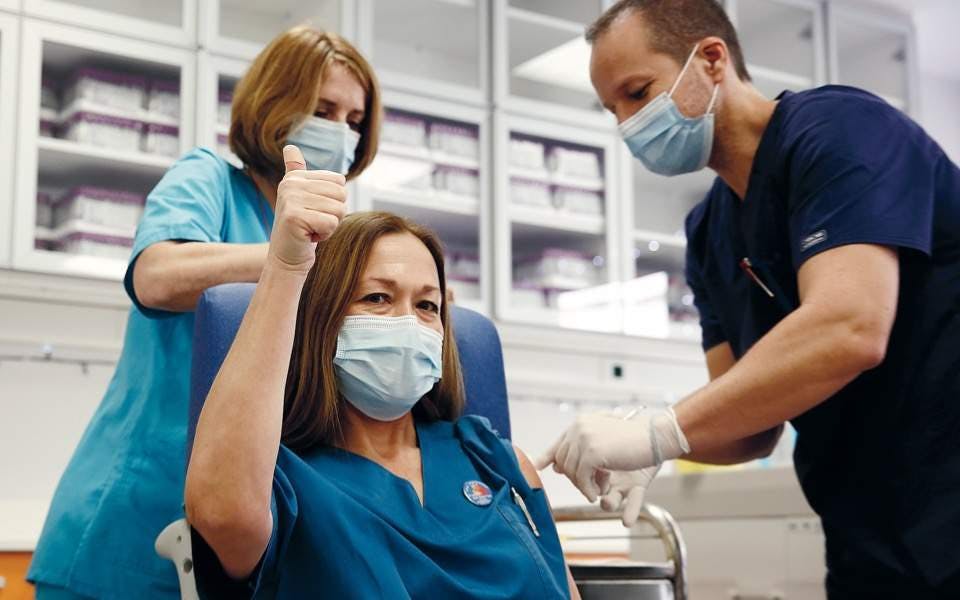In this system, a vaccine is just a commodity

The rapid development of vaccines against COVID-19 should be a positive, life-saving development. Happening at a speed many in the medical field would have previously thought impossible, these vaccines provide a glimmer of hope that an end to this once-in-a-century pandemic is possible.
But instead of national governments and pharmaceutical companies cooperating to vaccinate the world’s population as quickly as possible, other priorities are informing the distribution of vaccines.
For the governments of wealthy nations, vaccines represent a solution to their own criminal negligence. In much of the UK, Europe and the US, politicians refused or resisted locking down their economies long enough to eliminate community transmission and save lives, preferring to protect profits. The death toll in these countries continues to rise as the virus spreads out of control, as does the economic cost. Rapid mass vaccination is now widely seen as the only viable solution to this disaster, and governments in these countries are willing to fight each other to be first in the supply queue.
Such competition has characterised the vaccine development right from the beginning. When Oxford University started searching for a pharmaceutical company to manufacture its vaccine candidate, it initially struck a deal with the US company Merck. However, the deal collapsed when Merck refused to guarantee to prioritise supply to the UK. Oxford ended up partnering with AstraZeneca. AstraZeneca doesn’t actually specialise in vaccines, but when the UK government offered up-front funding to secure 100 million doses and allow AstraZeneca to build its first virus-manufacturing facility, the company was willing to expand its clinical portfolio and promise that UK citizens would be first in line for the jab.
However, AstraZeneca’s favouritism has angered the EU. The EU has forked out the significant sum of €336 million in a deal with the company to secure vaccine supplies. But in late January, delays in production resulted in AstraZeneca cutting supply to the EU by close to 75 percent, while supplies to the UK were unaffected. The EU retaliated by passing a regulation blocking COVID-19 vaccine exports to 100 countries, including the UK. This is not an isolated incident—last May, the drug company Sanofi found itself in a tug of war between the USA and France over its vaccine candidate.
But these spats amongst wealthy countries are only one part of the problem, and are likely to abate once production increases. A report from the Intelligence Unit at the Economist predicts that most of Europe, the UK and US will have widespread vaccination coverage by the end of 2021, with the remainder of the advanced economies likely to have coverage by mid-2022.
For the countries that cannot afford to pay, it is a different story. “[W]idespread vaccination coverage will not be achieved before 2023, if it happens at all” is the likely scenario for developing countries, according to the report.
This is because COVID-19 vaccines, and the companies competing to make them, are not charitable endeavours. The aim is to make money by selling to those who can pay. The vaccine industry pre-COVID was already estimated to be worth US$35 billion, and it will get a welcome boost from COVID-19. Pfizer alone is expected to make US$15 billion this year from its vaccine. To maximise these profits, supplies will go to the highest bidders.
There have been attempts to counter this inhuman market logic. India and South Africa, for example, proposed that the World Trade Organization remove intellectual property protections on leading vaccine candidates so that poorer countries could manufacture their own supplies. Unsurprisingly, the proposal was blocked by the US, UK and EU.
Another attempt is the creation of COVAX, a collaborative initiative led by the World Health Organization. The aim is to eliminate competition around vaccine distribution through the collective procurement of vaccines via negotiation with manufacturers, and equal distribution of supplies to participating COVAX countries. Donations and contributions from the wealthier countries are meant to subsidise the vaccine supply for countries that cannot afford to pay.
About 145 countries are currently participating in COVAX. However, many of the wealthier participating countries have also made private deals with vaccine manufacturers. This will in turn affect the supply available to COVAX. The initiative has a 2021 goal of distributing enough vaccines for 20 percent of the population in participating countries. But its latest report forecasts that, if all goes to plan, COVAX will distribute enough jabs to vaccinate only 3.3 percent of participating populations during the first half of 2021.
And even if it does eventually reach 20 percent coverage, COVAX currently has no plans to go beyond that goal. How nations depending on this initiative are supposed to vaccinate the remainder of their population is anyone’s guess.
This continues a pattern of health inequality in capitalist society. People living in developing countries suffer from countless illnesses that can easily be prevented and treated elsewhere. Sometimes the developed world has a charitable moment with medicines, but it usually comes years or decades after these medicines have become readily available in the developed world and have already made their manufacturers a fortune. Such were the experiences of the efforts to eradicate polio and distribution of the 2009 H1N1 flu pandemic vaccine and HIV antivirals.
Despite much lofty talk about saving lives, COVID-19 vaccines are commodities just like any other. With 2 million people already killed by the pandemic and many more under threat, the inhuman, profit-obsessed market will continue to decide who lives and who dies.